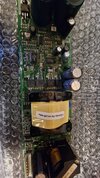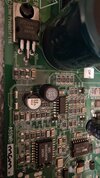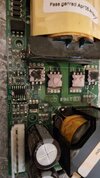CrashDown963
- Apr 9, 2023
- 7
- Joined
- Apr 9, 2023
- Messages
- 7
Hello everyone!
I've got my Linn Av 5125 which, mid play (volume was pretty high), died altogether.
Opened it up, and removed the SMPS from the unit, obvious burn mark on one of the resistors (R222, probably a current shunt, located in the bottom center of the board), tried powering it with a halogen attached, no voltage on output rails.
Fuse is not blown and tested good, changed it for good measure.
Mosfets not tested yet, due to annoying solder matrix on the underside which requires a heat gun (which i am, arguably, bad at using).
We're talking about a 500W unit, two rails, 36V.
I haven't tested any of the caps yet (I've tested them with capacitance mode, in circuit, so nothing reliable really), but I measured some opens on many diodes which I am going to outline. Would you guys have any suggestion on what happened, and what could be done to fix this?




I've got my Linn Av 5125 which, mid play (volume was pretty high), died altogether.
Opened it up, and removed the SMPS from the unit, obvious burn mark on one of the resistors (R222, probably a current shunt, located in the bottom center of the board), tried powering it with a halogen attached, no voltage on output rails.
Fuse is not blown and tested good, changed it for good measure.
Mosfets not tested yet, due to annoying solder matrix on the underside which requires a heat gun (which i am, arguably, bad at using).
We're talking about a 500W unit, two rails, 36V.
I haven't tested any of the caps yet (I've tested them with capacitance mode, in circuit, so nothing reliable really), but I measured some opens on many diodes which I am going to outline. Would you guys have any suggestion on what happened, and what could be done to fix this?











